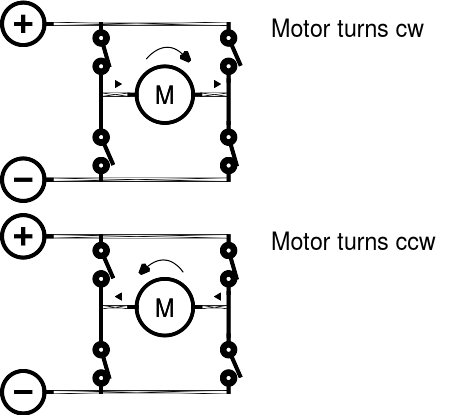(Created page with "An H-Bridge is a circuit of 4 switches allowing to select the direction of current flowing through a part. The simples H-Bridge consist of four manually controlled switches: Whe...") |
mNo edit summary |
||
| Line 5: | Line 5: | ||
[[File:H-BridgeLeftRight.svg]] | [[File:H-BridgeLeftRight.svg]] | ||
== Links == | |||
Circuit of an H-Bridge made of transistors, including free wheeling diodes and shortage prevention: http://www.mikrocontroller.net/articles/H-Br%C3%BCcken_%C3%9Cbersicht | Circuit of an H-Bridge made of transistors, including free wheeling diodes and shortage prevention: http://www.mikrocontroller.net/articles/H-Br%C3%BCcken_%C3%9Cbersicht | ||
[[Category:Electronics]] | |||
[[Category:Martin Schied]] | |||
Revision as of 01:12, 26 November 2011
An H-Bridge is a circuit of 4 switches allowing to select the direction of current flowing through a part. The simples H-Bridge consist of four manually controlled switches:
When using a simple H-Bridge it is important to prevent switches to short the supply voltage. In commercially available H-Bridges additional circuits prevent accidental short circuits.
Links
Circuit of an H-Bridge made of transistors, including free wheeling diodes and shortage prevention: http://www.mikrocontroller.net/articles/H-Br%C3%BCcken_%C3%9Cbersicht
